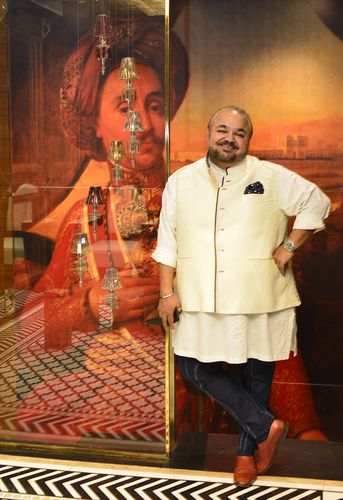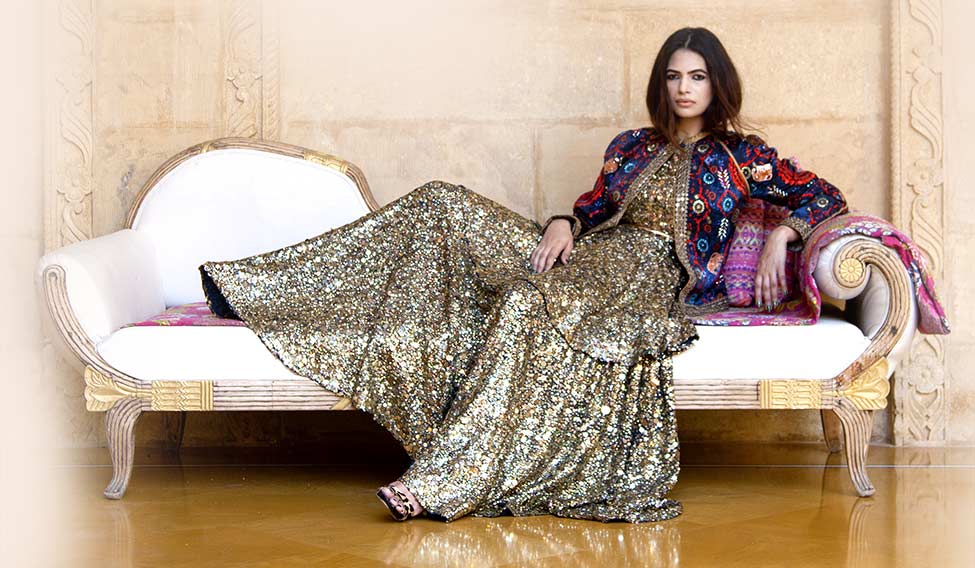 Man with a royal touch: J.J. Valaya at his flagship store in southwest Delhi | Arvind Jain
Man with a royal touch: J.J. Valaya at his flagship store in southwest Delhi | Arvind Jain
The Indian fashion industry is abuzz with talk that fashion designer J.J. Valaya is going through a financial crisis, but the couture king says he is strong-footed in an insecure industry where people constantly try to pull you down. “Haven’t you heard the crab joke? You should see the joy on people’s faces when they hear about someone’s problem. With a smile, they lament,” says the 50-year-old designer, who completes 25 years in the industry this year.
One of the reasons why people are talking about Valaya’s finances is that his luxury label ‘JJ Valaya’ has terminated its ready-to-wear line and closed down some of its stores. “We have seen that it is a formula that works [for ready-to-wear], but has to have the backing of high volumes, right amount of sale points and marketing. Otherwise, it is a no-brainer,” says Valaya, who is a founding member of the Fashion Design Council of India, the country’s apex fashion body.
The brand is focusing on consolidation, realising that spreading too thin too soon is counterproductive in business. So, instead of nearly a dozen fashion labels, there will be just three—JJ Valaya Diffusion, JJ Valaya Couture and JJ Valaya Muse—in fashion, besides JJ Valaya Home label in the home interior segment.
Diffusion will tread the middle path between casual wear and bridal garments, where quality parameters will be intact but the outfits will not be laden with work. The other two labels will offer occasion wear and bridal couture, respectively. “Our pricing will start from Rs 30,000,” he says.
The brand has joined hands with Austrian crystal producer Swarovski for fashion jewellery, luxury home products maker FCML for wall tiles and concept jewellery brand Azva for precious ornaments. In such licensing tie-ups, the designer gives the design input for new products, while the manufacturing rights are with the brand or company. In a way, it is a service that acts as revenue grosser for a designer. At times, the company asks or allows the designers to incorporate its products in their collections.
Moreover, Valaya is ready to start his ecommerce venture. By the end of 2017, his collections will begin their cyber catwalk through Valaya.com. “When the first dot com boom happened [two decades ago], I was sure that nothing above Rs 200 will sell. But over a period of time, I have realised that the Indian diaspora sitting in America, the UK and Australia are not going to come here again and again for buying our outfits,” says the designer, sitting in his sprawling 10,000sqft flagship store at The Gallery, a high-end mall in southwest Delhi. After India, the US is his second largest market, largely thanks to NRI clients.
The store can be easily mistaken for a modern-day palace. Strewn with antique pieces like metal vases, statues, paintings, tapestries and lithographs, it is a beautiful space that exudes Valaya’s love for history, royalty and opulence. The first level houses his couture collection, resembling the walk-in wardrobe of a maharaja. Above it is the Valaya Home Experience Centre, a sample flat designed by him, including flooring, furniture, wall installations, soft furnishings and home accessories. From the staircase displaying a mammoth painting of a royal man to the intricate carvings on the walls, everything here seems inspired by the majestic Indian palaces. And, why not? He was born in Jodhpur—the land of the royals. His formative years, however, were spent in Delhi, Pune, Lucknow and Chandigarh as his father was a chief engineer in the Army.
 Shimmer style: A model sporting a JJ Valaya creation.
Shimmer style: A model sporting a JJ Valaya creation.
But, Valaya is about to relocate the flagship store. “The vibe of this place is not right,” he says. But he will reveal the new address only when the store is ready. At a time when Delhi is brimming with fashion streets, it is a sensible move.
Like his business, his personality, too, seems to have changed. From a high-headed fashion czar, Valaya is now a warm and welcoming personality. Some industry insiders attribute the transformation to the rough financial weather.
But Valaya looks at it rather philosophically. “Over a period, I have come to the conclusion that neither the past nor the future really matters. You just focus on the present. It is my philosophy now in both professional and personal life,” he says.
He is dressed in his signature look—white kurta, black breeches, an ivory half-Nehru jacket and a ponytail. While he is known for his vibrant lines, colour has always eluded Valaya’s personal wardrobe—he rarely wanders beyond shades of ivory, white and black. “I feel they are very posh colours,” he says, adjusting his ivory pocket square. “Earlier I used to wear everything and tie a turban. Then I got into Indian clothing and started wearing kurtas and churidars with shawls. Gradually, I switched to my present style, as it takes care of both formal and casual look.”
And when did the turban go? A year after graduating from the National Institute of Fashion Technology, in 1992, Valaya won the alumni fashion designing contest. The prize was two economy tickets to Amsterdam, which could be confirmed only 24 hours before the departure, depending on availability of seats. “But I was excited, as it was my first foreign trip. While preparing for the trip, I chopped off my hair to be comfortable abroad,” recalls Valaya.
Before he took the fashion plunge, he was studying to be a chartered accountant. But just ahead of his final exams, he realised it didn’t interest him. “I didn’t know what I wanted to do, but I did know what I didn’t want to do,” he says. So, he quit his articleship with a CA firm, and sat at home for a few months contemplating what to do next. Then, one of his uncles told him about NIFT, Delhi.
“Everybody thought it was a tailoring course, as the concept of designers hadn’t come to India then,” says Valaya. “There were no private fashion institutes, no media coverage, no internet and almost no customers. There were no benchmarks and you had to learn everything from your mistakes.”
As soon as he graduated from NIFT, he borrowed Rs 5,000 from his father and launched his label. “But I consider 1992 as the year of the genesis of my business, as my brother T.J. Singh joined me that year after quitting his Army job. TJ also pulled out all his Provident Fund money and invested in the label,” says Valaya, who is married to Meghna and has two lovely daughters Hoorvi, 18, and Soumeya, 9.
But his fashion journey was no cakewalk. A few weeks after launching his label, Valaya showcased his first commercial line—an all ivory line—in Kolkata alongside designers Rohit Khosla, Rohit Bal and Gitanjali Kashyap. “The collection was a washout. Not a single garment was sold,” he says. But he didn’t give up and created a black-and-white jackets collection next. It was a runaway hit.
“You are never established and everything is never fine unless you, within yourself, think that everything is great,” says Valaya. A photographer by passion, he has now begun self-publishing photo travel books.






